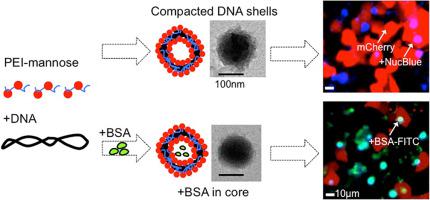Biomaterials Advances ( IF 7.9 ) Pub Date : 2021-05-19 , DOI: 10.1016/j.msec.2021.112184 Hashanthi K Abeyratne-Perera 1 , Saswati Basu 2 , Preethi L Chandran 3

|
Polyethyleneimine (PEI) polymers are known to compact DNA strands into spheroid, toroid, or rod structures. A formulation with mannose-grafted PEI (PEIm), however, was reported to compact DNA into ~100 nm spheroids that indented like thin-walled pressurized shells. The goal of the study is to understand why mannose bristles divert the traditional pathway of PEI-DNA compaction to produce shell-like structures, and to manipulate the process so that proteins can be packed into the core of the assembling shells for co-delivering DNA and proteins into cells. DLS, AFM, and TEM imaging provide a consistent picture that BSA proteins can be packed into the shells without altering the shell architecture, as long as the proteins were added during the time course of shell assembly. Force spectroscopy studies reveal that DNA shells that buckle also have a rich surface-coating of mannose, indicating that a micelle-like partitioning of hydrophobic and hydrophilic layers governs shell assembly. When HEK293T cells are spiked with BSA-laden DNA shells, co-transfection of DNA and BSA is observed at higher levels than control formulations. Distinct micron-sized features appear having both green fluorescence from BSA-FITC and blue fluorescence from NucBlue DNA stain, suggesting BSA release in nucleus and secretory granules. With DNA nanocontainers, proteins can take advantage of the efficiency of PEI-based DNA transfection for hitchhiking into cells while being shielded from the challenges of the intracellular route. DNA nanocontainers are rapid to assemble, not dependent on the DNA sequence, and can be adapted for different protein types; thereby having potential to serve as a high-throughput platform in scenarios where DNA and protein have to be released at the same site and time within cells (e.g., theranostics, multiplexed co-delivery, gene editing).
中文翻译:

作为纳米容器在多重递送中运输蛋白质的压缩 DNA 壳
已知聚乙烯亚胺 (PEI) 聚合物可将 DNA 链压缩成球状、环形或杆状结构。然而,据报道,含有甘露糖接枝 PEI (PEIm) 的配方可将 DNA 压缩成约 100 nm 的球体,这些球体像薄壁加压壳一样缩进。该研究的目的是了解为什么甘露糖刷毛会改变 PEI-DNA 压缩的传统途径以产生壳状结构,并操纵该过程,以便将蛋白质装入组装壳的核心以共同输送 DNA和蛋白质进入细胞。DLS、AFM 和 TEM 成像提供了一致的图片,即只要在壳组装的时间过程中添加蛋白质,BSA 蛋白就可以在不改变壳结构的情况下装入壳中。力谱研究表明,弯曲的 DNA 壳也具有丰富的甘露糖表面涂层,表明疏水层和亲水层的胶束状分区控制着壳的组装。当 HEK293T 细胞加入载有 BSA 的 DNA 壳时,观察到 DNA 和 BSA 的共转染水平高于对照制剂。不同的微米级特征似乎具有来自 BSA-FITC 的绿色荧光和来自 NucBlue DNA 染色的蓝色荧光,表明 BSA 在细胞核和分泌颗粒中释放。使用 DNA 纳米容器,蛋白质可以利用基于 PEI 的 DNA 转染的效率搭便车进入细胞,同时免受细胞内途径的挑战。DNA 纳米容器可以快速组装,不依赖于 DNA 序列,并且可以适应不同的蛋白质类型;因此,在必须在细胞内的相同位点和时间释放 DNA 和蛋白质的情况下(例如,治疗诊断学、多重共同递送、基因编辑),它有可能作为高通量平台。



























 京公网安备 11010802027423号
京公网安备 11010802027423号